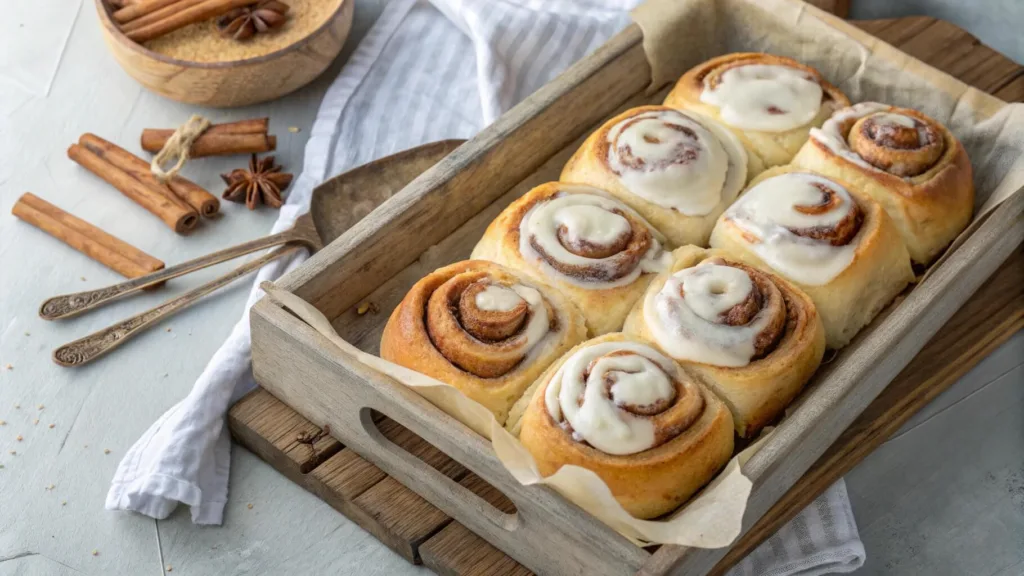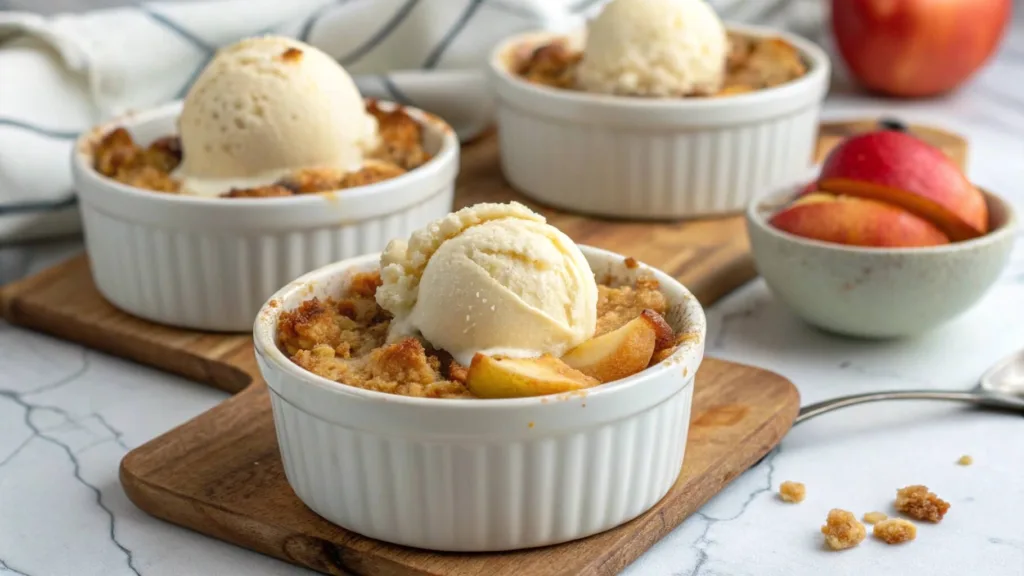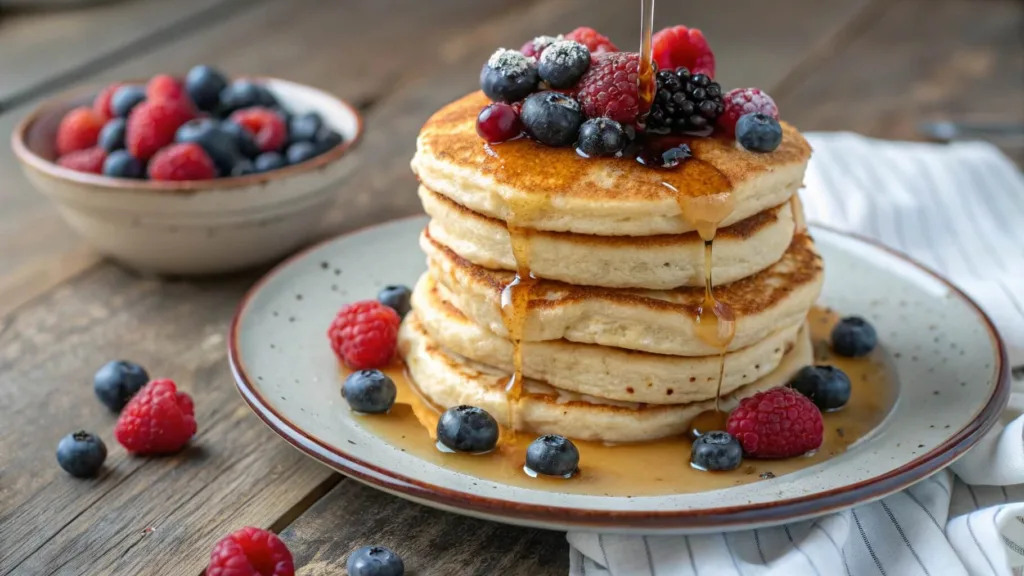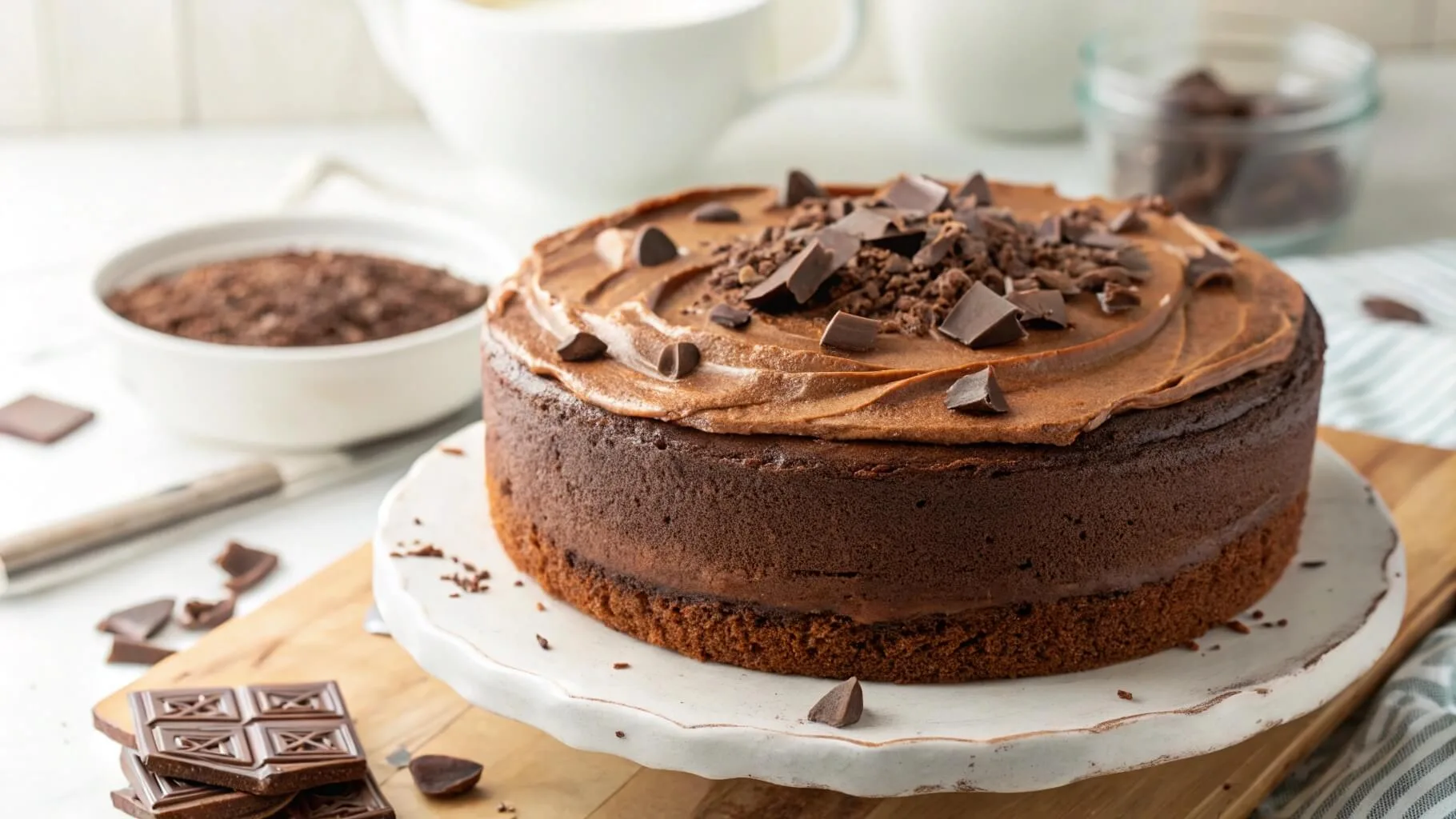Sourdough dessert recipes are a delightful way to transform the tangy magic of sourdough into sweet, indulgent treats. If you’ve always associated sourdough with bread or savory dishes, it’s time to explore its sweeter side. From rich chocolate cakes to fluffy pancakes, sourdough desserts offer a unique blend of tangy depth and natural sweetness that takes your favorite recipes to a whole new level.
In this guide, we’ll dive into everything you need to know about sourdough dessert recipes. You’ll discover the health benefits of baking with sourdough, expert tips for mastering dessert-making, and a lineup of irresistible recipes to satisfy your sweet tooth. Whether you’re a seasoned baker or just starting your sourdough journey, this guide will inspire you to create creative and delicious desserts that stand out.
Let’s explore the world of sourdough dessert recipes and uncover the secrets to baking treats that are as unique as they are delicious!
Introduction to Sourdough Dessert Recipes
What Makes Sourdough Dessert Recipes Unique?
Sourdough stands out because of its natural fermentation process. This process breaks down carbohydrates and proteins, giving desserts a softer texture and a rich, tangy flavor. Unlike traditional leavening agents like baking powder or yeast, sourdough creates a more complex flavor profile that pairs beautifully with sweet ingredients like chocolate, fruits, and spices.
Why Incorporate Sourdough into Your Baking?
Sourdough offers several advantages over conventional methods. It reduces the need for artificial additives, adds probiotics, and helps improve digestion. Baking with sourdough also allows for better control over sweetness levels, making it ideal for crafting desserts that aren’t overly sugary but still indulgent.
A Brief Overview of Sourdough Dessert Recipes Possibilities
From cakes and cookies to pancakes and cheesecakes, sourdough can elevate almost any dessert. Imagine the moistness of sourdough banana bread, the chewiness of sourdough brownies, or the fluffiness of sourdough cinnamon rolls. With the right techniques, you can transform your sourdough starter into a treasure trove of dessert magic.
The Health Benefits of Using Sourdough in Desserts
Nutritional Advantages of Sourdough Dessert Recipes
Sourdough desserts aren’t just delicious—they’re also packed with nutritional benefits. The natural fermentation process of sourdough breaks down phytic acid in flour, which can inhibit the absorption of vital nutrients like iron, zinc, and magnesium. This makes sourdough-based desserts more nutrient-dense compared to those made with conventional methods.
Additionally, sourdough’s fermentation process enriches the final product with B vitamins and organic acids, giving your desserts a slight nutritional edge. You can satisfy your sweet tooth while knowing your treats offer more than empty calories.
How Sourdough Affects Digestibility in Desserts
Sourdough’s fermentation breaks down gluten and starches, making it easier to digest. Even desserts that typically feel heavy, like chocolate cakes or rich brownies, can feel lighter when made with sourdough. Some people with mild gluten sensitivities find sourdough desserts gentler on their stomachs due to this pre-digestion process.
Moreover, sourdough’s probiotic-friendly properties can support gut health. Although baking kills live probiotics, the prebiotic compounds formed during fermentation remain intact, contributing to better digestion.
Lowering Sugar and Fat Content with Sourdough
Sourdough desserts often require less sugar and fat to achieve a moist, flavorful texture. The tangy flavor from the starter naturally balances sweetness, reducing the need for added sugars. Similarly, the fermentation process creates a tender crumb in baked goods, allowing you to cut back on oils or butter without compromising texture.
For example, in recipes like sourdough pancakes or banana bread, the starter adds a delightful tang and moisture, letting you use ripe bananas or natural sweeteners as healthier sugar substitutes.
Top 5 Classic Sourdough Dessert Recipes to Try

1. Sourdough Chocolate Cake
This rich, moist chocolate cake is a showstopper for any occasion. The tanginess of the sourdough balances the sweetness of the chocolate, creating a well-rounded flavor profile.
Ingredients Needed: Sourdough starter, cocoa powder, sugar, eggs, flour, and vanilla extract.
Pro Tip: Let your batter rest for 30 minutes before baking to allow the sourdough to work its magic on the texture.
2. Sourdough Banana Bread
Sourdough takes this classic dessert to a whole new level. The natural tang of the starter complements the sweetness of ripe bananas, making each bite a perfect harmony of flavors.
Ingredients Needed: Overripe bananas, sourdough starter, flour, sugar, eggs, and cinnamon.
Pro Tip: Add walnuts or dark chocolate chips for an extra layer of flavor and texture.
3. Sourdough Brownies
For a fudgy, chewy texture, sourdough is the ultimate secret ingredient in brownies. The starter creates a dense and satisfying dessert that melts in your mouth.
Ingredients Needed: Sourdough starter, unsweetened chocolate, butter, sugar, eggs, and flour.
Pro Tip: Sprinkle sea salt on top for a gourmet touch that enhances the chocolate’s richness.
4. Sourdough Cinnamon Rolls
Fluffy, tender, and loaded with cinnamon sugar, sourdough cinnamon rolls are a crowd-pleaser. The starter adds a unique depth to the flavor, making these rolls irresistible.
Ingredients Needed: Sourdough starter, flour, milk, butter, sugar, cinnamon, and cream cheese for the frosting.
Pro Tip: Allow the dough to rise overnight for a deeper sourdough tang and softer texture.
5. Sourdough Pancakes with a Sweet Twist
Transform your breakfast routine with sourdough pancakes. These are light, fluffy, and perfect for a sweet breakfast treat or dessert.
Ingredients Needed: Sourdough starter, flour, eggs, milk, sugar, and baking powder.
Pro Tip: Top with fresh berries, whipped cream, or a drizzle of maple syrup for a luxurious finish.
Creative Sourdough Dessert Recipes for Special Occasions

1. Sourdough Cheesecake Bars
These creamy, tangy cheesecake bars with a sourdough crust are perfect for parties or gatherings. The sourdough adds a slight tartness to the crust that pairs beautifully with the sweet, creamy filling.
Ingredients Needed: Sourdough starter, graham crackers, cream cheese, sugar, and eggs.
Pro Tip: Add a swirl of fruit puree on top for a pop of color and flavor.
2. Sourdough Apple Crumble
A cozy dessert that’s perfect for fall, sourdough apple crumble combines the tartness of sourdough with the sweetness of baked apples and a crunchy crumble topping.
Ingredients Needed: Sourdough starter, fresh apples, cinnamon, brown sugar, oats, and butter.
Pro Tip: Serve warm with a scoop of vanilla ice cream for a comforting treat.
3. Sourdough Carrot Cake
Carrot cake gets an upgrade with the addition of sourdough. The starter enhances the cake’s moistness and adds complexity to the spiced flavors.
Ingredients Needed: Sourdough starter, grated carrots, flour, sugar, eggs, cinnamon, and cream cheese for the frosting.
Pro Tip: Add crushed pineapple to the batter for an extra layer of moisture and sweetness.
4. Pairing Sourdough Desserts Recipes with Drinks
Elevate your dessert experience by pairing sourdough treats with complementary drinks. For example:
- Sourdough Cheesecake Bars: Pair with a fruity white wine or sparkling cider.
- Sourdough Apple Crumble: Enjoy with a warm cup of spiced chai or black tea.
- Sourdough Carrot Cake: A hot latte or cappuccino is a perfect match.
Tips for Perfecting Your Sourdough Dessert Recipes
How to Adapt a Sourdough Starter for Desserts
Using sourdough in desserts requires slight adjustments to the starter to complement sweeter flavors. A well-fed, active starter with a mild tang is ideal for dessert recipes.
Key Tips:
- Feed your starter with equal parts all-purpose flour and water to keep the flavor balanced.
- Avoid letting your starter ferment too long, as this increases sourness, which may overpower desserts.
- For sweeter recipes, try feeding the starter with a touch of sugar or honey to enhance its flavor.
Common Mistakes to Avoid
Many bakers struggle to find the right balance when incorporating sourdough into desserts. Avoid these pitfalls for better results:
- Overly Tangy Desserts: Use a freshly fed starter to reduce sourness.
- Dense Baked Goods: Let your dough or batter rest for an adequate time to allow the starter to work its magic.
- Overmixing the Batter: This can deflate the natural aeration from fermentation, leading to dense textures.
Balancing Flavors with Sourdough
Sourdough introduces a unique tangy note, but it shouldn’t dominate the dessert. Here’s how to create harmony:
- Pairing with Sweet Ingredients: Use ingredients like chocolate, vanilla, or fruits to balance the tang.
- Using Spices: Warm spices such as cinnamon, nutmeg, and cardamom complement sourdough’s complexity.
- Adjusting Sweetness: Increase sugar slightly in recipes where tanginess might overpower.
How to Create and Maintain a Dessert-Ready Sourdough Starter
Step-by-Step Guide to Starting a Sourdough Starter
Creating a sourdough starter from scratch is easier than you might think. Follow these steps to build a starter perfect for desserts:
- Day 1: Mix 1/2 cup of all-purpose flour and 1/4 cup of water in a clean jar. Cover loosely and let sit at room temperature for 24 hours.
- Day 2–4: Feed the starter daily with 1/4 cup of flour and 2 tablespoons of water, discarding half of the mixture before feeding. Bubbles should begin to form by day 3.
- Day 5: Your starter is ready when it doubles in size within 4-6 hours of feeding and has a mild, pleasant smell.
How to Sweeten Your Sourdough Starter for Desserts
Dessert-ready starters require subtle sweetness to complement baked goods. Here’s how to modify your starter:
- Switch to Sweet Flour: Use white whole wheat or pastry flour to create a milder flavor.
- Add Sugar: Add a teaspoon of sugar or honey to each feeding to tone down the tang.
- Feed More Frequently: Feed your starter twice daily for a few days before using it to create a fresh, milder starter.
Storing and Reusing Your Starter
Proper storage ensures your starter remains active and ready for future baking projects.
- Refrigeration: If you bake weekly, store your starter in the fridge and feed it once a week.
- Freezing: For long-term storage, freeze the starter in an airtight container and thaw when needed.
- Reactivating: Bring the starter to room temperature and feed it 1-2 times to reactivate before using in desserts.
Gluten-Free and Vegan Sourdough Dessert Options

Making Vegan Sourdough Cakes and Cookies
You can easily make vegan desserts with your sourdough starter by replacing animal-based ingredients with plant-based alternatives. Sourdough’s natural fermentation process adds flavor and texture, even without eggs or dairy.
Vegan Substitutions:
- Replace eggs with flaxseed meal (1 tablespoon flaxseed + 3 tablespoons water = 1 egg).
- Use plant-based milk (almond, oat, or soy milk) instead of dairy milk.
- Swap butter for coconut oil or vegan margarine.
Example: Vegan sourdough chocolate chip cookies with coconut oil create a rich, chewy texture with a hint of tang from the starter.
Gluten-Free Sourdough Pancakes
If you’re avoiding gluten, you can still enjoy sourdough desserts by using a gluten-free starter. Replace wheat flour with gluten-free blends containing rice flour, tapioca starch, and potato starch.
Steps for Gluten-Free Pancakes:
- Start with a gluten-free sourdough starter.
- Combine the starter with gluten-free flour, almond milk, and a touch of vanilla extract.
- Cook pancakes on medium heat until golden and fluffy.
Pro Tip: Add fresh blueberries or dark chocolate chips for extra flavor.
Ingredient Substitutions for Healthier Options
- Flour: Use almond flour, coconut flour, or oat flour for added nutrients.
- Sweeteners: Swap white sugar for natural options like maple syrup, agave, or coconut sugar.
- Fats: Replace butter with Greek yogurt or applesauce for lighter desserts.
These modifications allow you to create sourdough desserts that cater to dietary preferences while retaining their delightful flavors.
FAQs About Sourdough Dessert Recipes
1. Is sourdough good for desserts?
Absolutely! Sourdough enhances the texture and flavor of desserts by adding a subtle tang and depth of flavor. It also improves moisture retention, making cakes, cookies, and breads more tender and longer-lasting.
2. Why is sourdough bread not fattening?
Sourdough is often less fattening than other breads because its fermentation process lowers the glycemic index, which helps regulate blood sugar levels. Additionally, it promotes better digestion and nutrient absorption, making it a healthier choice overall. When used in desserts, it can help balance sugar and fat content without compromising flavor.
3. What is the biggest mistake you can make with your sourdough starter?
The most common mistake is neglecting your starter. Forgetting to feed it regularly or using it when it’s over-fermented can lead to overly tangy or dense baked goods. For desserts, it’s crucial to use a fresh, well-fed starter to maintain a mild flavor and optimal rise.
4. Why is sourdough healthier than other bread?
Sourdough is healthier because its fermentation process breaks down gluten and phytic acid, improving digestibility and making nutrients like magnesium and zinc more bioavailable. In desserts, these benefits carry over, allowing you to create indulgent treats with added nutritional perks.
Expert Tips from Bakers on Sourdough Dessert Recipes
Advice on Perfecting Texture and Flavor
- Choose the Right Starter: Use a mildly tangy starter for desserts to avoid overwhelming the sweetness. Feed your starter a day before using it for optimal activity.
- Hydration Matters: Adjust the hydration of your starter depending on the dessert. For cakes, a wetter starter ensures a moist crumb, while cookies and brownies benefit from a firmer starter.
- Rest Your Batter: Allow your sourdough dessert batter to rest for at least 30 minutes to develop better flavor and texture.
Baking Hacks for First-Time Sourdough Bakers
- Don’t Overmix: Gently fold your ingredients to preserve the starter’s natural rise. Overmixing can lead to dense desserts.
- Experiment with Flavors: Sourdough pairs well with bold flavors like dark chocolate, citrus, and warm spices, so don’t hesitate to get creative.
- Test Small Batches: If you’re trying a new recipe, start with a small batch to perfect your technique before scaling up.
Best Tools for Sourdough Dessert Recipes Success
- Kitchen Scale: Precision is key when working with sourdough, so weigh your ingredients for consistent results.
- Stand Mixer: A stand mixer with a dough hook can save time and ensure even mixing for recipes like sourdough cinnamon rolls.
- Thermometer: Check the internal temperature of baked goods to confirm doneness—most desserts are ready at around 190°F–200°F.
Why You Should Experiment with Sourdough Dessert Recipes Today
Sourdough isn’t just for bread—it’s a game-changer for desserts too. From its unique tangy flavor to its health benefits, sourdough opens up a world of possibilities for creative and delicious baking. Whether you’re making rich chocolate cakes, fluffy pancakes, or indulgent cinnamon rolls, sourdough adds depth, texture, and a touch of sophistication to your sweet treats.
Incorporating sourdough into desserts not only improves their taste but also offers better digestibility and enhanced nutrient absorption. By using a well-fed starter and balancing its tangy notes with sweet or spiced ingredients, you can craft desserts that are as nutritious as they are indulgent.
For first-time bakers, sourdough might seem daunting, but with a bit of practice and the right techniques, it becomes a rewarding and versatile tool in your kitchen. Don’t shy away from experimenting with gluten-free and vegan options, or trying out unique recipes for special occasions.
So why wait? Grab your starter, explore the recipes shared here, and embark on a flavorful adventure that will delight your taste buds and impress your loved ones. With sourdough, the possibilities are endless!

